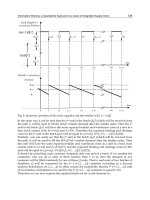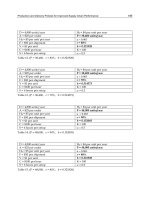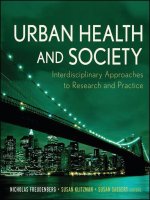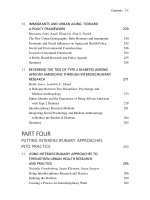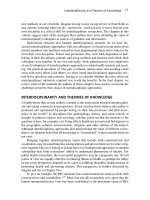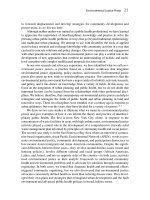Urban Health and Society: Interdisciplinary Approaches to Research and Practice - Part 9 ppt
Bạn đang xem bản rút gọn của tài liệu. Xem và tải ngay bản đầy đủ của tài liệu tại đây (119.44 KB, 10 trang )
Notes 61
46. Williams, D. R., and Collins, C. Racial residential segregation: A fundamental
cause of racial disparities in health. Public Health Reports, 116 (2001): 404 – 416.
47. Israel, B. A., Schulz, A. J., Parker, E. A., and Becker, A. B. Review of community -
based research: Assessing partnership approaches to improve public health. Annual
Review of Public Health, 19 (1998): 173 – 202.
48. Barnes, S. L. The Cost of Being Poor: A Comparative Study of Life in Poor
Urban Neighborhoods in Gary, Indiana. Albany: State University of New York
Press, 2005.
49. Aylott, R., and Mitchell, V. An exploratory study of grocery shopping stressors.
British Food Journal, 101 (1999): 683 – 700.
50. Glanz, K., Sallis, J. F., Saelens. B. E., and Frank, L. D. Nutrition environment
measures survey in stores (NEMS - S): Development and evaluation. American
Journal of Preventive Medicine, 32 (2007): 282 – 289.
51. Glanz, K., and Yaroch, A. L. Strategies for increasing fruit and vegetable intake
in grocery stores and communities: Policy, pricing, and environmental change.
Preventive Medicine, 39, Suppl 2 (2004): S75 – 80.
52. Cummins, S., Petticrew, M., Higgins, C., Findlay, A., and Sparks L. Large scale
food retailing as an intervention for diet and health: Quasi - experimental evalua-
tion of a natural experiment. Journal of Epidemiology and Community Health, 59
(2005): 1035 – 1040.
53. Wrigley, N., Warm, D., and Margetts, B. Deprivation, diet and food retail access:
Findings from the Leeds “ food deserts ” study. Environment and Planning A, 35
(2003): 151 – 188.
c03.indd 61c03.indd 61 6/3/09 11:59:03 AM6/3/09 11:59:03 AM
c03.indd 62c03.indd 62 6/3/09 11:59:03 AM6/3/09 11:59:03 AM
CHAPTER
4
AN ECOLOGICAL
MODEL OF URBAN
CHILD HEALTH
KIM T. FERGUSON, PILYOUNG KIM,
JAMES R. DUNN, GARY W. EVANS
LEARNING OBJECTIVES
■ D e fi ne the term ecological model and explain its utility in interdisciplinary research
in urban health.
■ Describe key infl uences on the health of urban children at various levels of social
organization (e.g., individual, family, community, policy).
■ Describe some of the ways that researchers have studied these infl uences on child
health across multiple levels.
■ Identify questions on the health of urban children that require ecological research
approaches to answer.
c04.indd 63c04.indd 63 6/3/09 11:59:54 AM6/3/09 11:59:54 AM
64 An Ecological Model of Urban Child Health
INTRODUCTION
Approximately 10 million children under the age of fi ve, including 4 million infants
under the age of one month, die every year from causes that are largely preventable,
1 –
3
including preventable and/or treatable diseases such as diarrheal dehydration, acute
respiratory infection, measles, malaria, and HIV.
1 ,
2
In fact, three of the fi ve most
signifi cant contributors to the global burden of disease are primarily or exclusively
childhood diseases — namely, perinatal conditions, lower respiratory infections, and
diarrheal diseases.
1 ,
2
In addition, malnutrition contributes to over a third of all child
deaths worldwide.
2 ,
4
Although children living in rural areas are almost twice as likely to
be malnourished as children living in urban areas,
2
and child mortality rates are typically
higher in rural areas,
1
high morbidity, mortality, and malnutrition rates are nevertheless
serious concerns for urban children worldwide, especially in the developing world.
Furthermore, there is some evidence that, with increasing rates of rural - urban migration
and the resulting growth of the urban poor, this urban advantage is decreasing and may
not exist when socioeconomic status is controlled for.
5 –
7
Urbanization has been on the incline since the Industrial Revolution, with 46 percent
of the world ’ s population living in cities in 2000 as opposed to just 5 p ercent at the
beginning of the nineteenth century.
8 ,
9
This trend is expected to continue, and in fact,
global population growth in the next thirty years will be primarily in cities, with approx-
imately two - thirds of the world ’ s population living in cities by 2040.
9 ,
10
Children may be disproportionately affected by the environmental challenges
inherent in poor urban neighborhoods.
1 1 –
13
Child illnesses and malnutrition infl uence
various aspects of child development, including cognitive development and intellec-
tual performance.
14 –
24
Further, child mental and physical health predict later health
during adolescence and adulthood.
22 ,
23
Thus, healthy children grow up to be healthy
adults.
22
It is therefore critical that public health researchers and practitioners consider
the specifi c factors affecting the health of urban children in developing intervention
strategies for improving global health and development. In this chapter, we suggest a
conceptual framework wherein the complex interrelations among biological, psycho-
social, and physical factors infl uencing child health in urban environments can be
studied.
AN ECOLOGICAL MODEL
Ecological contexts have long been recognized as infl uential in determining popula-
tion health. For example, in a discussion on housing conditions and health, Saegert
and Evans
25
described the powerful infl uence of housing location and its determinants
in shaping the multiple social and physical risks low - income and minority urban fami-
lies face.
Although some research on urban public health has adopted an ecological per-
spective, individual studies tend to assess the infl uences of very specifi c ecological
contexts at only one level (e.g., housing and health, neighborhood poverty and crime).
c04.indd 64c04.indd 64 6/3/09 11:59:54 AM6/3/09 11:59:54 AM
Bronfenbrenner’s Bioecological Model 65
By contrast, in its World Health Report for 2005, the World Health Organization
suggests taking an integrated rather than an isolated approach in developing both
assessments of and interventions to improve child health.
26
Indeed, considerable
research indicates that health interventions are most effective when implemented at
multiple levels.
27 –
33
Thus, this chapter calls for an integrated ecological approach to the
study of urban public health, employing Bronfenbrenner ’ s bioecological model to
assess the infl uences of the ecological context at multiple levels over time on child
health. We use this theoretical framework as a heuristic to examine what is known and
what needs to be looked at further among the multiple, intersecting ecological niches
cities provide for children and their families, with a specifi c focus on how such com-
plex urban contexts infl uence children ’ s health. We then lay out an agenda for future
work in light of the Bronfenbrenner bioecological model.
BRONFENBRENNER ’ S BIOECOLOGICAL MODEL
Bronfenbrenner originally conceptualized his bioecological model as a framework for
studying development within the actual environments in which people live.
34 –
40
There-
fore, this framework lends itself well to the study of urban health within an ecological
framework, which necessarily emphasizes the interaction between characte ristics of the
person and characteristics of the environment in determining specifi c health outcomes.
29
Further, in contrast to other ecological models employed in urban health research, in the
formulation of their bioecological framework, Bronfenbrenner and colleagues have spe-
cifi cally identifi ed some of the characteristics of the person and the environment that
have an impact on development. They have further specifi ed mechanisms through which
interactions between person and environment characteristics may infl uence develop-
ment and health.
Process - Person - Context - Time
Within Bronfenbrenner ’ s bioecological model are four interacting dimensions that
should be considered when studying development in context — namely, process, person,
context, and time (PPCT; see Figure 4.1 ).
40
The fi rst of these, process, is at the core of
the model, and it encompasses exchanges of energy between an organism and the envi-
ronment that operate over time.
37 ,
39 ,
40
These enduring forms of progressively more
complex reciprocal interactions between active and evolving human organisms and the
persons, objects, and symbols in their immediate external environments, termed proxi-
mal processes, are critically important in driving development.
39 ,
40
For the purposes of
this chapter, proximal processes can be thought of as two - way interactions between the
child and the objects and people in his or her immediate environment that may infl u-
ence health (see Figure 4.1 ). A simple example would be the ways a child learns to
communicate to her parent whether she is ill and needs medical treatment, while at the
same time the parent learns to identify the child ’ s need for medical treatment from her
behavior.
c04.indd 65c04.indd 65 6/3/09 11:59:54 AM6/3/09 11:59:54 AM
Process
Time
(Chronosystem)
Person
Person
Macrosystem
Exosystem
Microsystem
Proximal Processes
FuturePresentPast
Mesosystem
Context
FIGURE 4.1 Bronfenbrenner’s Bioecological Model: Process, Person, Context, Time (PPCT)
c04.indd 66c04.indd 66 6/3/09 11:59:54 AM6/3/09 11:59:54 AM
Bronfenbrenner’s Bioecological Model 67
The power of proximal processes in directing development is posited to vary as a
function of various characteristics of the developing person, including behavioral dis-
positions, resources, and demand characteristics.
40
The distinction between these
different types of person characteristics as conceptualized in Bronfenbrenner ’ s model
is not essential for our present purposes. What is important to note is that much research
evidence indicates that various characteristics of the developing person do indeed shape
both mental and physical health. For example, self - motivation, self - effi cacy, and self -
esteem all positively infl uence health and well - being.
41 ,
42
Some evidence suggests that
the aggressiveness of physicians ’ treatments for persons suffering from heart attacks
varies by gender, whereby physicians treat males more aggressively than females.
43
Another defi ning property of Bronfenbrenner ’ s bioecological model is time, which
is characterized at three different levels — namely, microtime (continuity vs. discontinu-
ity within episodes of proximal processes), mesotime (the periodicity of these episodes
of proximal processes across longer time intervals such as days or weeks), and macrotime
(changing expectations and events in the larger society that may infl uence individual
development).
40
As with the specifi c aspects of the person as conceptualized in the
Bronfenbrenner model, the different levels of time are not a critical consideration for
our present purposes. However, given the importance of enduring reciprocal interac-
tions between persons and their environment in directing development, we can see that
the regularity and predictability of events across time directly infl uences children ’ s
development, including their health. For example, children living in families with
greater turmoil (e.g., frequent arguments between parents and parental divorce or sepa-
ration) have elevated cardiovascular activity.
44 ,
45
Further, the regularity of events and
levels of unpredictability and confusion in the home are related to children ’ s mental
health, independent of socioeconomic status (SES).
46 –
48
Finally, in terms of the ecological context, Bronfenbrenner and colleagues have
argued that development occurs within four nested and interacting systems — namely
the microsystem, the mesosystem, the exosystem, and the macrosystem (see Figure 4.2 ).
40
All four systems are important for understanding children ’ s health in urban environ-
ments. The microsystem consists of the settings directly experienced by the child (e.g.,
the family, the peer group, the school, and the immediate neighborhood). The meso-
system consists of connections between these microsystems (e.g., the interaction
between parents ’ expectations of the child in terms of nonrisky health behavior and the
expectations of the child ’ s peers). The exosystem is comprised of linkages and pro-
cesses between settings that do not contain but directly infl uence the child (e.g.,
parental work settings, the larger neighborhood). The macrosystem is the overarching
pattern of micro - , meso - , and exosystems that is characteristic of a given culture or
subculture. Thus, the ecological context infl uences the critical proximal processes that
underlie human development at multiple levels. In the present chapter, we focus on
how both physical and social environmental factors at these different levels infl uence
child health.
c04.indd 67c04.indd 67 6/3/09 11:59:55 AM6/3/09 11:59:55 AM
68 An Ecological Model of Urban Child Health
INFLUENCES ON CHILDREN ’ S HEALTH IN THE URBAN CONTEXT
We turn now to a brief discussion of some of the key factors having an impact on urban
children ’ s health. It should be emphasized that our purpose here is not to provide a
comprehensive overview of the current literature on urban children ’ s health but instead
to consider some ways this literature could be understood, and future research could
be conducted, within an ecological framework. Thus, we have identifi ed key factors of
the physical and social environment that have demonstrated impacts on children ’ s
health at each level of the child ’ s environment, from her immediate surroundings to
the larger culture in which she is embedded. Some of these factors have been identifi ed
by public health researchers as “ leverage points ” — individual and environmental fac-
tors that have the most signifi cant impact on a given health outcome.
29 ,
31
Understanding
the impact of such critical factors on child health is an essential fi rst step in developing
appropriate intervention strategies at multiple levels.
Macrosystem
Physical and Social Environment: Urban Environments The macrosystem is the
overarching pattern of micro - , meso - , and exosystem factors characteristic of a given
culture or subculture.
40
Urban environments can be seen as a macrosystem that leads to
FIGURE 4.2 Bronfenbrenner’s Bioecological Model: Context
Macrosystem
Attitudes and ideologies
of the culture
Extended
family
Friends of
family
Parents‘
work
Child
Housing
Peers
Health
services
School
Neighbors
Mass
media
Social welfare
services
Family
Play-
ground
Exosystem
Mesosystem
Microsystem
c04.indd 68c04.indd 68 6/3/09 11:59:55 AM6/3/09 11:59:55 AM
Infl uences on Children’s Health in the Urban Context 69
specifi c micro - , meso - , and exosystem characteristics, as well as to certain proximal
processes acting over time. For example, three hallmark characteristics of urban envi-
ronments — namely, complexity, diversity, and density — were introduced in the
introductory chapter of this volume. These characteristics operate at multiple levels of
the urban environment (including at the immediate level of the family and at the more
external level of parents ’ work environments) and infl uence practices and beliefs of
parents and their children, thus affecting child health in a unique way (Figure 4.3 ).
These characteristics are briefl y considered here in light of their possible role in the
health of urban children. We also discuss how these factors fi t within Bronfenbrenner ’ s
ecological model.
C omplexity is one of the defi ning characteristics of an urban environment.
49
T w o
dimensions of complexity in cities are the heterogeneity of urban populations (micro-
system) and neighborhoods (microsystem and exosystem),
33 ,
49 –
51
both encompassed
within the overall characteristic of diversity, and the heterogeneity of both housing
(microsystem) and neighborhood (exosystem) density.
52
This heterogeneity is partly a
result of the high immigration rates that are typical of cities. Further, cities change over
time, a characteristic important to consider in assessing the most critical factors infl u-
encing urban child health, which may well change as cities evolve.
49
Some of this high
rate of change over time is partly due to the high mobility and residential turnover that
Macrosystem
Complexity
Parents‘
work environments
Parents
Child
Diversity
Density
Immediate
neighborhood
Greater
neighborhood
Environmental
chaos
Exosystem
Mesosystem
Microsystem
FIGURE 4.3 The Urban Environment as a Macrosystem
c04.indd 69c04.indd 69 6/3/09 11:59:55 AM6/3/09 11:59:55 AM
70 An Ecological Model of Urban Child Health
are typical of urban environments, which result in disruptions in the child ’ s immediate
environment (microsystem) as well as in environments not immediately affecting the
child, such as parents ’ work environments (exosystem).
These dimensions of complexity render urban environments particularly challenging
to study in terms of identifying the various factors infl uencing health. The development
and application of multilevel, multidimensional models in studying urban health is thus
of critical importance.
27 –
33 ,
49
Diversity exists both between and within cities. Between different cities in differ-
ent parts of the world, different characteristics of the physical and social environment
may be more or less salient and may infl uence health in different ways.
49
For example,
the lack of safe water and poor sanitation critically infl uence urban child health
in the developing world,
11 ,
13
factors that may be less critically important infl uences in
the developed world. These can be conceptualized as factors operating at the level
of the macrosystem, as they differ between large, complex environments. By contrast,
overcrowding and other factors characteristic of poor quality housing in urban areas
have a direct impact on child mental and physical health in both developing and
developed cities.
11 ,
25 ,
46 ,
50 ,
53 ,
54
They can thus be considered components of the child ’ s
microsystem. These differences require researchers to be cautious in making genera-
lizations about the critical infl uences of urban living on health in urban environments.
It is also essential that differences between different children ’ s experiences be consid-
ered at the level at which they operate.
Within cities, diversity encompasses the heterogeneity of both urban populations
and neighborhoods and housing quality and type.
33 ,
49 –
51
Urban populations are hetero-
geneous along the dimensions of ethnicity, income, and socioprofessional status, among
other factors.
33 ,
49
As we will discuss in some detail later, characteristics such as SES
critically infl uence child health and operate both in the microsystem (e.g., within fami-
lies, schools, and immediate neighborhoods) and the exosystem (e.g., the larger
neighborhood).
55 –
56
Differing neighborhood characteristics are similarly correlated
with differential child mental and physical health outcomes, again as detailed later in
this chapter.
11 ,
46 ,
50 ,
51 ,
53 ,
54
Yet another level of complication in assessing the infl uences of various ecological
factors on child health in urban environments is the fact that person and neighborhood
characteristics are often interrelated; for example, neighborhood segregation tends to
occur along ethnic and socioeconomic lines.
25 ,
50
We thus discuss SES as operating
across levels in the following section. Further, both housing and neighborhood density
are heterogeneous within cities such that low - income, minority families are more
likely to live in homes and neighborhoods characterized by residential crowding.
52
Thus, poor, ethnic minority urban children are exposed to considerably more environ-
mental and psychosocial stressors related to poverty than are suburban white children;
these stressors in turn infl uence child health at multiple levels.
15 ,
52 ,
55 ,
56
In many urban areas, inequality is pervasive; low - income residents, including
children, lack access to adequate health and social services, which typically operate at
c04.indd 70c04.indd 70 6/3/09 11:59:55 AM6/3/09 11:59:55 AM

